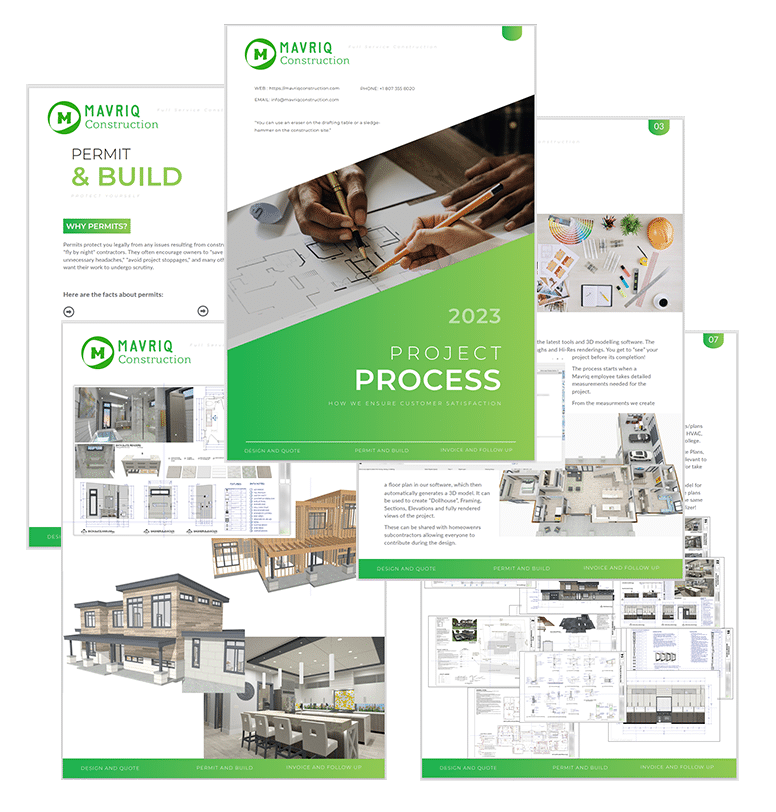Design and Permits
3D Building Design
Frank Lloyd Wright said it best: "You can use an eraser on the drafting table or a sledge hammer on the construction site." Plans and drawings are essential and permits put an independent set of eyes on build. From conceptualizing innovative building designs to navigating the intricacies of permits, our team excels in providing comprehensive solutions tailored to your needs. We utilize cutting-edge 3D design technology, ensuring that every aspect of your project is meticulously planned and executed to perfection. See your project before it is built!
Start Your ProjectOur Designers
Mavriq Construction has registered designers available for any residential, commercial, or light industrial project. You may find it helpful to read about our project process and how it can help you with your next project.
We use the latest 3D design software, so you can see the project before it is built. Many architects in the residential realm are still working with older 2D-based software. While it may fit the need to create permit drawings, they usually only show orthographic views, making it hard to visualize your project. In addition it often misses important design considerations that crop up during the build, and cost you more.
We can build a 3D model, create your drawings from it, and obtain your permit for a fraction of the price of using an architect.
We can build a 3D model, create your drawings from it, and obtain your permit for a fraction of the price of using an architect.
Design Categories
Permits
Permits are Scary! Well for many people that is. The truth is they are not that difficult a process provided you have good drawings. We can obtain your permits for you. If you want to approach this yourself, take a look at the information below.
We are often asked, "When is a permit required"?
The answer is in the Ontario building code act:
"No person shall construct or demolish a building or cause a building to be constructed or demolished unless a permit has been issued therefor by the chief building official."
The key words are "construct" and "demolish", both of which are defined in the act as well:
Construct - "means to do anything in the erection, installation, extension or material alteration or repair of a building and includes the installation of a building unit fabricated or moved from elsewhere "
Demolish - "means to do anything in the removal of a building or any material part thereof"
The short of it is, legally, you need a permit for every job. The permit office wants to avoid being tied up with drywall repairs, toilet changes, etc., so most don't care if you get one. If you alter plumbing, electrical, structure, insulation, add walls etc, you need one
The answer is in the Ontario building code act:
"No person shall construct or demolish a building or cause a building to be constructed or demolished unless a permit has been issued therefor by the chief building official."
The key words are "construct" and "demolish", both of which are defined in the act as well:
Construct - "means to do anything in the erection, installation, extension or material alteration or repair of a building and includes the installation of a building unit fabricated or moved from elsewhere "
Demolish - "means to do anything in the removal of a building or any material part thereof"
The short of it is, legally, you need a permit for every job. The permit office wants to avoid being tied up with drywall repairs, toilet changes, etc., so most don't care if you get one. If you alter plumbing, electrical, structure, insulation, add walls etc, you need one
Most clients we talk to seem afraid of the permit process. They've heard horror stories about inspectors walking in and flagging issues outside the project's scope, long wait times for the permit, or other equally upsetting matters. This is no longer the case, at least with most building offices.
Several years ago, the government changed the building code to encourage more people to get permits. Heavy-handed inspectors and building offices that operated like customer service was beneath them are strongly discouraged. Ontario updated the laws to define officials' powers and restrict a permits' time to be issued.
Several years ago, the government changed the building code to encourage more people to get permits. Heavy-handed inspectors and building offices that operated like customer service was beneath them are strongly discouraged. Ontario updated the laws to define officials' powers and restrict a permits' time to be issued.
In Ontario, a permit MUST be issued in 10 business days for a residential project or 15 days for a commercial. Don't buy any "who haw" a plans reviewer may give you. Unless you held them up, the law is clear: The permit must be in your hands within that time frame. Ultimately the Chief Building Official is responsible for ensuring that happens. If a reviewer on inspector is holding you up, ask to speak with them. That alone usually lights a fire
Once notified of the completion of a stage, an inspector must be on-site within 48 business hours. In our experience, it is often quicker than that.
Usually, the deed for the project's location, payment, a few forms, and construction documents. Building offices have generally clamped down on the quality of construction documents required. So don't expect a hand drawing on a napkin to work anymore.
Anyone can, but ultimately the property owner has to give consent.
That depends on the scope of the project. For small projects, a single drawing may be ok, but a set of plans would be needed for something more complicated.
Homeowners can create their own documents or submit contractors' drawings. However, the documents must show all aspects of the project.
As part of the overhaul of the building code laws, Ontario created registered building practitioners. These designers offer an alternative to architects and engineers for smaller building designs. The idea is to get better quality drawings to permit offices, reduce costs to homeowners, and help building offices get permits out faster. They must carry insurance similar to architects and engineers and undergo training and testing by Humber College. They are issued what is known as a BCIN number and are registered with the province. They also have to pass testing on the Ontario Building Code Act, and can help navigate red tape if issues arise.
Our Project Process

At Mavriq Construction, our project process begins with a thorough assessment of the client's needs and objectives. Once we have a clear understanding of the project requirements, we engage our team of registered designers who bring their expertise and creativity to the table. The designers work closely with the client to develop concepts and designs that align with the project goals. Throughout the process, our project managers ensure that timelines are met, budgets are adhered to, and quality standards are upheld.
You may find it helpful to read about our project process and how it can help you with your next residential, commercial, or light industrial project.
You may find it helpful to read about our project process and how it can help you with your next residential, commercial, or light industrial project.
Get the Downloadable Guide or click to see the online version.














